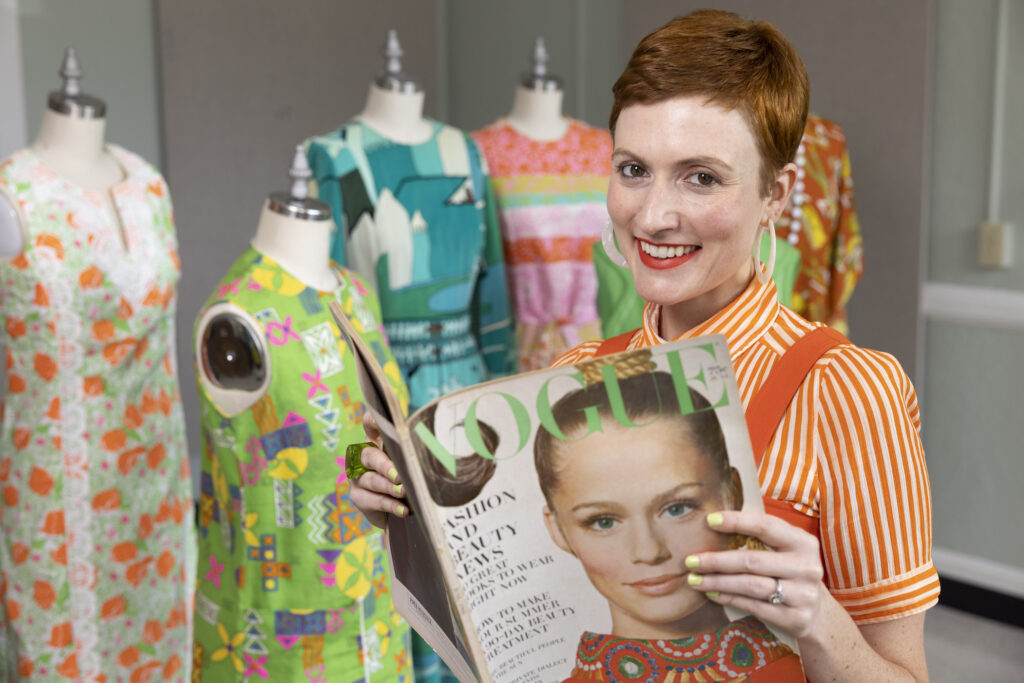Sara Idacavage fell in love with vintage fashion in college.
She liked to thrift shop in her earlier years. But when she came to the University of Georgia for her undergraduate degree in fashion merchandising, it cemented her love for fashion and history.
“I think that the more you study and learn about fashion, the greater your interest in vintage fashion becomes. Every single piece tells a story,” she said.
In Athens, she’d shop at Dynamite and Agora for vintage clothing. “I was studying fashion at the same time, and I’d have such a greater appreciation for everything. I would think about why is the zipper here, and why does this pocket have significance?”
In class, she was learning about designers, fabric dyes, fashion history and trends—all while building her own vintage collection.
Sara Idacavage runs a popular Instagram account dedicated to vintage fashion finds. She started the historyalamode account to share interesting garments she was working in New York archives. (Photo by Peter Frey/UGA)
Grad school and working in corporate archives
After college, she headed to New York for a journalism career. Between going to New York vintage stores and museum exhibitions, she eventually returned to her love for fashion and history and pursued a master’s degree in fashion studies from The New School’s Parsons School of Design. Her emphasis was in fashion history and material culture.
“I fell in love with historic clothing collections and preserving their stories, and decided to dedicate my life to studying these objects,” she said.
After graduating, she spent a year working in The New School Archives and Special Collections as their fashion specialist, cataloging designer sketches and photographs. She interned at the Museum of the City of New York. Then, she worked in the corporate archives of fashion designers, including Ralph Lauren. She helped archive tens of thousands of garments ranging from past collections to inspiration pieces and would often have to pull garments for designers with a moment’s notice.
“It was really cool to see it from the designer’s perspective,” she said.
“I think I’ve always been drawn to fashion, to the element of being able to dress up,” she said. But fashion is also “very closely tied to all aspects of human history, and I really just want to study as many subjects as I can through the lens of clothing and fashion.
“You’re literally putting yourself into someone else’s shoes when you’re studying these historical pieces. You can imagine what it was like to walk and sit in these garments,” she said.
Teaching
After gaining that experience, Parsons asked her to teach a research seminar and she continued to teach a variety of courses, including fashion history, at Parsons, the Pratt Institute and the Fashion Institute of Technology.
She wasn’t seriously thinking about a Ph.D. at first, but when she came up with the concept for her dissertation, she decided she really needed to return to school in order to dig deeper into sustainable fashion.
“I like to tell stories with what I wear,” said Sara Idacavage, a doctoral student at UGA. She loves color—bright colors. She might wear a romper with a nod to Lily Pulitzer prints or a dress by Emilio Pucci, who attended the University of Georgia. (Photo by Peter Frey/UGA)
Back at UGA
Now, Idacavage is back at the University of Georgia College of Family and Consumer Sciences to work on her Ph.D., focusing on the use of sustainability to frame historical inquiry. Her research places contemporary issues with the fashion system in a broader historical context in order to disrupt the unsustainable ideas, practices and institutions that have become normalized.
“I want to help people develop a more complex understanding of sustainability and encourage a more transdisciplinary and problem-oriented approach to history,” she said.
The idea to pursue this research was inspired by noticing how strongly her students reacted to learning about how people appreciated their clothing in the past, such as the ways clothing was meticulously mended and passed down over generations and how clothing was used as a form of currency during the Renaissance.
She’s also working toward a museum studies certificate. She calls working with UGA’s Historic Clothing and Textile Collection a continuation of the work she had been doing with a study collection at Parsons.
“Fashion is such a strong force in our lives,” she said. “We are attracted to these objects. I don’t want people to just completely abstain from participating in the fashion system. You can enjoy fast fashion and still be mad about unfair labor practices. We need to focus on systemic change rather than feeling guilt and shame over individual actions.”
Ultimately, she just wants people to think a little more deeply about that shirt or dress they buy.
“Clothes can still bring people such joy,” she said.
